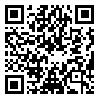Fri, Apr 26, 2024
[Archive]
Volume 18, Issue 4 (10-2014)
2014, 18(4): 272-281 |
Back to browse issues page
Download citation:
BibTeX | RIS | EndNote | Medlars | ProCite | Reference Manager | RefWorks
Send citation to:



BibTeX | RIS | EndNote | Medlars | ProCite | Reference Manager | RefWorks
Send citation to:
Rezaie nasab T, Salehi I, Kafi S M, Rezaei S. The validity, diagnostic value and replicability of Bender Visual-Motor Gestalt Test in traumatic brain injury patients. Hormozgan Medical Journal 2014; 18 (4) :272-281
URL: http://hmj.hums.ac.ir/article-1-1732-en.html
URL: http://hmj.hums.ac.ir/article-1-1732-en.html
Abstract: (23 Views)
Introduction: Bender Gestalt test is one of the most famous neuropsychological tests that is simple and it can be used to examine brain injuries. The objective of this research was to investigate the validity, diagnostic strength and the replicability of the Bender Visual-Motor Gestalt Test in patients with traumatic brain injury (TBI). Methods: 240 participants were tested in a case-control study to examine the validity of this test in two groups included 120 patients with TBI and normal cases. All participants were involved in the study by non-probability and consecutive sampling method. The normal group was matched with the TBI group in terms of age, gender and education level. The Bender Gestalt Test, neurological and dissectional information questionnaire, the demographic variable lists of the patients and the mini-mental examination test (MMSE) were used to collect the data. Results: Findings showed that patients with TBI showed more frequency in Gestalt test's dozen errors than the normal group. The discriminant validity coefficient showed that, in total 98.3% of the participants had been placed correctly in two normal and patient groups. The concurrent validity coefficient with the MMSE was -0.53 and the item-total correlation of this test were in a range of 0.10 to 0.48. The replicability results of this test among three examiners through intraclass correlation coefficient (ICC) calculations were 0.81 and the cronbach's Alpha coefficient for the total sample was 0.85. Conclusion: This test has an acceptable discriminant and replicability strength. Regarding the obtained validity and reliability coefficients, it is recommended that this test be applied with the paraclinical diagnostic tools (such as CT-scan and MRI) as the screening tools in patients with TBI.
| Rights and permissions | |
 |
This work is licensed under a Creative Commons Attribution-NonCommercial 4.0 International License. |




